Discovering the Fine-Scale Morphology of the Gulf of Cádiz: An Underwater Imaging Analysis
Abstract
:1. Introduction
2. Regional Settings
3. Materials and Methods
3.1. Data Acquisition
3.2. Direct Observation Data Analysis
3.3. Geostatistic Analysis
4. Results
4.1. Large-Scale Spatial Analysis
4.1.1. Turbidite Channels Zone
4.1.2. Contourite Channels Zone
4.1.3. Diapiric Ridges Zone
4.1.4. Contourite Deposits Zone
4.2. Fine-Scale Spatial Analysis
4.2.1. Ripples
- (a)
- Straight ripples are two-dimensional bedforms with continuous lateral ridges, with a straight plan view and asymmetrical profile. They have an average value of the wavelength of 8.17 cm, with values between 5 and 10.8 cm, and their height ranges between 0.5 and 4 cm, with an average value of 2.5 cm. They are associated with flow rates between 0.2 and 0.3 m/s and develop on sand and muddy sand sediments. These ripples have been identified in the contourite channels zone, arranged perpendicular to the dune leeside (Figure 4a).
- (b)
- Ladder-back ripples are composed of a main set of straight ripples perpendicular to the dune leeside, and a secondary set of overlapping ripples with an angle of 90° over the former (Figure 4b). The main set has continuous lateral crests, with a linear plan view and asymmetrical profile. They have an average wavelength value of 7.7 cm and a height of 1 cm. The secondary set consists of laterally discontinuous straight ripples, with a linear plan view and symmetrical profile. They have wavelengths around 7 cm and heights of 0.5 cm. These ladder-back ripples are associated with sandy sediments and flow rates around 0.30 m/s. As well as the straight ripples, ladder-back ripples have been identified in the contourite channels, associated with some dune leeside (Figure 4b).
- (c)
- Sinuous ripples are three-dimensional bedforms that have continuous lateral crests and transverse to the flow, with a wavy plan view and asymmetrical transversal profile. The crestlines are generally out of phase, with a wavelength ranging between 7 and 9.7 cm and an average value of 8 cm. They have heights between 1 and 3.5 cm, with an average value of 1.7 cm. They are associated with flow rates between 0.29 and 0.34 m/s and develop on sandy and muddy sand sediments. In leeside, they usually have large accumulations of biogenic material. This type of ripple was identified mainly at the edges of the contourite channels, although they are also observed in the depressions of the west flank of the diapiric ridges (Figure 4c).
- (d)
- Disorganized sinuous ripples are 3-dimensional bedforms that have discontinuous lateral ridges and transverse to the flow, with a wavy plan view and asymmetric profile. The crest lines are out phase, with wavelengths between 6 and 16 cm, and an average value of 11.5 cm. The height varies between 0.7 and 1.6 cm, and the average value is 1 cm. These ripples are associated with flow rates between 0.23 and 0.34 cm/s and develop over sand sediments. These ripples were identified in the contourite channels and the contourite deposits with greater current speeds (Figure 4d).
- (e)
- Linguoid ripples are 3-dimensional bedforms that have discontinuous and transverse crest to the current flow, with a moon plan view and asymmetric profile. The different lines of crests are out phase, with an average wavelength value of 10.4 cm, and ranging between 5 and 20 cm. The height reached by these ripples varies between 0.5 and 5 cm, the average value being 2.7 cm. They are associated with flow rates between 0.23 and 0.31 m/s and develop on sand and sandy mud sediments. In the lee side, they have accumulations of biogenic sediment of greater grain size. Linguoid ripples, like the previous ones, were identified in the contourite channels and the zones of higher velocity of the bottom current (Figure 4e).
4.2.2. Dunes
4.2.3. Obstacle Marks
- (a)
- Sandy marks consist of elongated mounds that are generated leeward from the obstacle. These mounds reach up to 0.5 m in length and are associated with obstacles up to 10 cm high. Around the obstacle, a small erosive groove of between 0.5 and 1 cm is generated (Figure 7a,b). These marks are related to sandy sediments and flow rates around 0.23 m/s.
- (b)
- Coarse sediment marks are small depressions generated around and leeward from the obstacle. They are generally associated with obstacles of more than 25 cm in height that generate marks of more than 2 m in length (Figure 7c,d). These marks are related to flow rates around 0.32 m/s and sandy and mixed sediments.
4.2.4. Burrows and Mounds
4.2.5. Plane Beds
4.2.6. Rocky Bottoms
4.3. Grouping Analysis
5. Discussion
Bedforms Spatial Distribution and Involved Processes
6. Conclusions
Author Contributions
Funding
Informed Consent Statement
Acknowledgments
Conflicts of Interest
References
- Guerrero, Q. Bedforms and Associated Sediment Dynamics on the Inner Shelves at Different Spatio-Temporal Scales. Ph.D. Thesis, Universitat de Barcelona, Barcelona, Spain, 2018. [Google Scholar]
- Hollister, C.D.; Heezen, B.C. Geologic effects of ocean bottom currents. In Studies in Physical Oceanography; Gordon, A.L., Ed.; Gordon and Breach Science Publishers: New York, NY, USA, 1972; Volume 2, pp. 37–66. [Google Scholar]
- Kenyon, N.H.; Belderson, R.H. Bedforms of the Mediterranean undercurrent observed with sidescan sonar. Sediment. Geol. 1973, 9, 77–99. [Google Scholar] [CrossRef]
- Bridge, J.S.; Best, J.L. Flow, sediment transport and bedform dynamics over the transition from dunes to upper-stage plane beds: Implications for the formation of planar laminae. Sedimentol 1988, 35, 753–763. [Google Scholar] [CrossRef]
- Wiberg, P.L.; Nelson, J.M. Unidirectional flow over asymmetric and symmetric ripples. J. Geophys. Res. 1992, 97, 12745–12761. [Google Scholar] [CrossRef]
- Baas, J.H. Dimensional Analysis of Current Ripples in Recent and Ancient Depositional Environments. Ph.D. Thesis, Utrecht University, Heidelberglaan, The Netherlands, 1993. [Google Scholar]
- van Rijn, L.C. Principles of Sediment Transport in Rivers, Estuaries, and Coastal Seas, 2nd ed.; Aqua Publications: Blokzijl, The Netherlands, 1993; p. 654. [Google Scholar]
- Southard, J.B.; Boguchwal, L.A. Bed configurations in steady unidirectional water flows. Part 2. Synthesis of flume data. J. Sediment. Pet. 1990, 60, 658–679. [Google Scholar] [CrossRef]
- Stow, D.A.V.; Hernández-Molina, F.J.; Llave, E.; Sayago-Gil, M.; Díaz del Rio, V.; Branson, A. Bedform-velocity matrix: The estimation of bottom current velocity from bedform observations. Geology 2009, 37, 327–330. [Google Scholar] [CrossRef]
- Bass, J.H.; Best, J.L.; Peakall, J. Predicting bedforms and primary current stratification in cohesive mixtures of mud and sand. J. Geological. Soc. 2016, 173, 12–45. [Google Scholar] [CrossRef] [Green Version]
- Van der Werf, J.J.; Schrijvershof, R.A.; Brakenhoff, L.B.; Grasmeijer, B.T. Observations of near-bed orbital velocities and small-scale bedforms on the Dutch lower shoreface. Ocean. Coast. Manag. 2022, 218, 106012. [Google Scholar] [CrossRef]
- Kirca, V.S.O.; Saghebian, S.M.; Roushangar, K.; Yagci, O. Influence of surface roughness of dune bedforms on flow and turbulence characteristics. Int. J. Sediment Res. 2020, 35, 666–678. [Google Scholar] [CrossRef]
- Allen, J.R.L. Current Ripples: Their Relations to Pattern of Water and Sediment Motion; North Holland Publishing Company: Amsterdam, The Netherlands, 1968; p. 433. [Google Scholar]
- Dingler, J.R.; Inman, D.L. Wave-formed ripples in nearshore sands. Coast. Eng. 1976, 15, 2109–2126. [Google Scholar] [CrossRef] [Green Version]
- Southard, J.B. Experimental determination of bed-form stability. Annu. Rev. Earth Planet Sci. 1991, 19, 423–455. [Google Scholar] [CrossRef]
- Venditti, J.G.; Church, M.; Bennett, S.J. Morphodynamics of small-scale superimposed sand waves over migrating dune bedforms. Water Resour. Res. 2005, 41, 1–14. [Google Scholar] [CrossRef] [Green Version]
- Perillo, M.M.; Best, J.L.; Garcia, M.H. A New Phase Diagram for Combined-Flow Bedforms. J. Sediment. Res. 2014, 84, 301–313. [Google Scholar] [CrossRef]
- Swift, D.J.P.; Parker, G.; Lanfredi, N.W.; Perillo, G.; Figge, K. Shoreface-connected sand ridges on American and European shelves: A comparison. Estuar. Coast. Mar. Sci. 1978, 7, 257–273. [Google Scholar] [CrossRef]
- Kleinhans, M.G.; Passchier, S.; Van Dijk, T. The origin of megaripples, long wave ripples and Hummocky Cross-Stratification in the North Sea in mixed flows. In Marine Sandwave and River Dune Dynamics II; Hulscher, S., Garlan, T., Idier, D., Eds.; University of Twente: Enschede, The Netherlands, 2004; pp. 142–151. [Google Scholar]
- Masson, D.G.; Wynn, R.B.; Bett, B.J. Sedimentary environment of the Faroe-Shetland and Faroe Bank Channels, north-east Atlantic, and the use of bedforms an indicator of bottom current velocity in the deep ocean. Sedimentology 2004, 51, 1207–1241. [Google Scholar] [CrossRef]
- Wynn, R.B.; Stow, D.A.V. Recognition and interpretation of deep-water sediment waves: Implications for palaeoceanography, hydrocarbon exploration and flow process interpretation. Mar. Geol. 2002, 192, 1–3. [Google Scholar] [CrossRef]
- Trincardi, F.; Normark, W.R. Sediment waves on the Tiber prodelta slope: Interaction of deltaic sedimentation and currents along the shelf. Geo-Mar. Lett. 1988, 8, 149–157. [Google Scholar] [CrossRef]
- Lee, G.; Dade, W.B.; Friedrichs, C.T.; Vincent, C.E. Examination of reference concentration under waves and currents on the inner shelf. J. Geophys. Res. 2004, 109, 1–10. [Google Scholar] [CrossRef] [Green Version]
- Puig, P.; Ogston, A.S.; Guillén, J.; Fain, A.M.V.; Palanques, A. Sediment transport processes from the topset to the foreset of a crenulated clinoform (Adriatic Sea). Cont. Shelf Res. 2007, 27, 452–474. [Google Scholar] [CrossRef]
- Davies, A.G.; Thorne, P.D. Advances in the study of moving sediments and evolving seabeds. Surv. Geophys. 2008, 29, 1–36. [Google Scholar] [CrossRef] [Green Version]
- Lyons, A.; Fox, W.; Hasiotis, T.; Pouliquen, E. Characterization of the Two-Dimensional Roughness of Wave-Rippled Sea Floors Using Digital Photogrammetry. IEEE J. Ocean. Eng. 2002, 27, 515–524. [Google Scholar] [CrossRef]
- Gerdes, K.; Martínez-Arbizu, P.; Schwarz-Schamera, U.; Schwentner, M.; Kihara, C. Detailed Mapping of Hydrotermal Vent Fauna: A 3D Reconstruction Approach Based on Video Imagery. Front. Mar. Sci. 2019, 6, 1–21. [Google Scholar] [CrossRef] [Green Version]
- Howe, J.A.; Humphery, J.D. Photographic evidence for slope-current activity, Hebrides Slope, NE Atlantic Ocean. Scott. J. Geol. 1995, 30, 107–115. [Google Scholar] [CrossRef]
- Wynn, R.B.; Masson, D.G.; Bett, B.J. Hydrodynamic significance of variable ripple morphology across deep-water barchan dunes in the Faroe-Shetland Channel. Mar. Geol. 2002, 192, 309–319. [Google Scholar] [CrossRef]
- Nelson, C.H.; Baraza, J.; Maldonado, A.; Rodero, J.; Escutia, C.; Barber, J.H. Influence of the Atlantic inflow and Mediterranean outflow currents on Late Quaternary sedimentary facies of the Gulf of Cadiz continental margin. Mar. Geol. 1999, 155, 99–129. [Google Scholar] [CrossRef]
- Habgood, E.; Kenyon, N.; Masson, D.; Akhmetzhanov, A.; Weaver, P.; Gardner, J.; Mulder, T. Deep-water sediment wave fields, bottom current sand channels and gravity Flow channel-lobe systems: Gulf of Cadiz, NE Atlantic. Sedimentology 2003, 50, 483–510. [Google Scholar] [CrossRef]
- Hernández-Molina, F.J.; Llave, E.; Somoza, L.; Fernández-Puga, M.C.; Maestro, A.; León, R.; Barnolas, A.; Medialdea, T.; García, M.; Vázquez, J.T.; et al. Looking for clues to paleoceanographic imprints: A diagnosis of the Gulf of Cadiz contourite depositional systems. Geology 2003, 31, 19–22. [Google Scholar] [CrossRef] [Green Version]
- García, M.; Hernández-Molina, F.J.; Llave, E.; Stow, D.A.V.; Leon, R.; Fernández-Puga, M.C.; Díaz del Rio, V.; Somoza, L. Contourite erosive features caused by the Mediterranean outflow water in the Gulf of Cadiz: Quaternary tectonic and oceanographic implications. Mar. Geol. 2009, 257, 24–40. [Google Scholar] [CrossRef]
- Fernández-Salas, L.M.; Sánchez-Leal, R.; Rueda, J.L.; López-González, N.; Díaz del Río, V.; López-Rodríguez, F.J.; Bruque, G.; Vázquez, J.T. Interacción entre las masas de agua, los relieves submarinos y la distribución de especies bentónicas en el talud continental del Golfo de Cádiz. Geo-Temas 2012, 13, 569–572. [Google Scholar]
- Hernández-Molina, F.J.; Wahlin, A.; Bruno, M.; Ercilla, G.; Llave, E.; Serra, N.; Rosón, G.; Puig, P.; Rebesco, M.; Van Rooij, D.; et al. Oceanographic processes and morphosedimentary products along the Iberian margins: A new multidisciplinary approach. Mar. Geol. 2016, 378, 127–156. [Google Scholar] [CrossRef] [Green Version]
- Sánchez-Leal, R.F.; Bellanco, M.J.; Fernández-Salas, L.M.; García-Lafuente, J.; Gasser-Rubinat, M.; González-Pola, C.; Hernández-Molina, F.J.; Pelegrini, J.L.; Peliz, A.; Relvas, P.; et al. The Mediterranean Overflow in the Gulf of Cadiz: A rugged journey. Sci. Adv. 2017, 3, eaao0609. [Google Scholar] [CrossRef] [Green Version]
- Stow, D.A.V.; Hernández-Molina, F.J.; Llave, E.; Bruno, M.; García, M.; Díaz-del-Río, V.; Somoza, L.; Brackenridge, R.E. The Cádiz Contourite Channel: Sandy contourites, bedforms and dynamic current interaction. Mar. Geol. 2013, 343, 99–114. [Google Scholar] [CrossRef] [Green Version]
- Ercilla, G.; Casas, D.; Hernández-Molina, F.J.; Roque, C. Generation of Bedfroms by the Mediterranean Outflow Current at the Exit of the Strait of Gibraltar. In Atlas of Bedforms in the Western Mediterranean; Springer: Cham, Switzerland, 2016; pp. 273–280. [Google Scholar]
- Maldonado, A.; Nelson, C.H. Interaction of tectonic and depositional processes that control the evolution of the Iberian Gulf of Cadiz margin. Mar. Geol. 1999, 155, 217–242. [Google Scholar] [CrossRef] [Green Version]
- Hernández-Molina, F.J.; Lobo, F.J. El Margen Continental del Golfo de Cadiz. In Memoria del Mapa Geomorfológico de España 1:1.000.000: Geomorfología de la Zona Sumergida Española; Martín-Serrano, A., Nozal, F., Maestro, A., Eds.; Servicio de Publicaciones Instituto Geológico y Minero de España: Madrid, Spain, 2005. [Google Scholar]
- Palomino, D. Geomorfología de Montes Submarines y su Relación con los Procesos Geológicos Recientes en Márgenes Continentales al sur de España. Ph.D. Thesis, Universidad de Cádiz, Cádiz, Spain, 2016. [Google Scholar]
- García, M.; Llave, E.; Hernández-Molina, F.J.; Lobo, F.J.; Ercilla, G.; Alonso, B.; Casas, D.; Mena, A.; Fernández-Salas, L.M. The role of late Quaternary tectonic activity and sea-level changes on sedimentary processes interaction in the Gulf of Cadiz upper and middle continental slope (SW Iberia). Mar. Pet. Geol. 2020, 121, 104595. [Google Scholar] [CrossRef]
- Hernández-Molina, F.J.; Llave, E.; Stow, D.A.V.; García, M.; Somoza, L.; Vázquez, J.T.; Lobo, F.; Maestro, A.; Díaz del Río, V.; León, R.; et al. The Contourite Depositional System of the Gulf of Cadiz: A sedimentary model related to the bottom current activity of the Mediterranean Outflow Water and its interaction with the continental margin. Deep Sea Res. Part II 2006, 53, 1420–1463. [Google Scholar] [CrossRef]
- Fernández-Puga, M.C.; Váquez, J.T.; Somoza, L.; Díaz del Río, V.; Medialdea, T.; Mata, M.P.; León, R. Gas-related morphologies and diapirism in the Gulf of Cadiz. Geo-Mar. Lett. 2007, 27, 213–221. [Google Scholar] [CrossRef]
- Somoza, L.; Díaz-del-Río, V.; León, R.; Ivanov, M.; Fernández-Puga, M.C.; Gardner, J.M.; Hernández-Molina, F.J.; Pinheiro, L.M.; Rodero, J.; Lobato, A.; et al. Seabed morphology and hydrocarbon seepage in the Gulf of Cadiz mud volcano area: Acoustic imagery, multibeam and ultra-high resolution seismic data. Mar. Geol. 2003, 195, 153–176. [Google Scholar]
- Palomino, D.; López-González, N.; Vázquez, J.T.; Fernández-Salas, L.M.; Rueda, J.; Sánchez-Leal, R.; Díaz-del-Río, V. Multidisciplinary study of mud volcanoes and diapirs and their relationship to seepages and bottom currents in the Gulf of Cádiz continental slope (northeastern sector). Mar. Geol. 2016, 378, 196–212. [Google Scholar] [CrossRef]
- Ochoa, J.; Bray, N.A. Water mass exchange in the Gulf of Cadiz. Deep Sea Res. A 1991, 38, 465–503. [Google Scholar] [CrossRef]
- Serra, N.; Ambar, I.; Käse, R.H. Observations and numerical modelling of the Mediterranean outflow splitting and eddy generation. Deep Sea Res. Part II 2005, 52, 383–408. [Google Scholar]
- Price, J.F.; Baringer, M.O.; Lueck, R.G.; Johnson, G.C.; Ambar, I.; Parrilla, G.; Cantos, A.; Kennelly, M.A.; Sanford, T.B. Mediterranean outflow mixing and dynamics. Science 1993, 259, 1277–1282. [Google Scholar]
- Díaz del Río, V.; Bruque, G.; Fernández-Salas, L.M.; Rueda, J.L.; González, E.; López, N.; Palomino, D.; López, F.J.; Farias, C.; Sánchez, R.; et al. Volcanes de Fango del Golfo de Cádiz, Proyecto LIFE + INDEMARES; Fundación Biodiversidad del Ministerio de Agricultura, Alimentación y Medio Ambiente: Madrid, Spain, 2014; p. 128. [Google Scholar]
- Troupin, C.; Barth, A.; Sirjacobs, D.; Ouberdous, M.; Brankart, J.M.; Brasseur, P.; Rixen, M.; Alvera-Azcarate, A.; Belounis, M.; Capet, A.; et al. Generation of analysis and consistent error fields using the Data Interpolating Variational Analysis (DIVA). Ocean Model. 2012, 52, 90–101. [Google Scholar] [CrossRef] [Green Version]
- Lozano, P.; Rueda, J.L.; Gallardo-Núñez, M.; Farias, C.; Urra, J.; Vila, Y.; López-González, N.; Palomino, D.; Sánchez-Guillamón, O.; Vázquez, J.T.; et al. Habitat distribution and associated biota in different geomorphic features within a fluid venting area of the Gulf of Cádiz (Southwestern Iberian Peninsula, Northeast Atlantic Ocean). In Seafloor Geomorphology Benthic Habitat; Elsevier: Amsterdam, The Netherlands, 2020; pp. 847–861. [Google Scholar]
- Folk, R.L. The distinction between grain size and mineral composition in sedimentary rock nomenclature. J. Geol. 1954, 62, 344–359. [Google Scholar] [CrossRef]
- Long, D. BGS detailed explanation of seabed sediment modified Folk classification. In MESH (Mapping European Seabed Habitats) Report; Joint Nature Conservation Committee: Peterborough, UK, 2006. [Google Scholar]
- Simons, D.B.; Richardson, E.V. Resistance to Flow in Alluvial Channels; US Government Printing Office: Washington, DC, USA, 1966; p. 422-I. [Google Scholar]
- Ashley, G.M. Classification of large scale subaqueous bedforms: A new look at an old problem. J. Sediment. Pet. 1990, 60, 160–172. [Google Scholar]
- Lobo, F.J. Estructuración y Evolución Morfosedimentaria de un Sector del Margen Continental Septentrional del Golfo de Cádiz durante el Cuaternario Terminal. Bachelor’s Thesis, Cádiz University, Cádiz, Spain, 1995; p. 200. [Google Scholar]
- Cutter, G.R.; Diaz, R.J. Biological alteration of physically structured flood deposits on the Eel margin, northern California. Cont. Shelf Res. 2000, 20, 235–253. [Google Scholar] [CrossRef]
- Wheatcroft, R.; Wiberg, P.; Alexander, C.; Bentley, S.; Drake, D.; Harris, C.; Ogston, A. Post-depositional alteration and preservation of sedimentary strata. Cont. Marg. Sediment. 2007, 37, 101–155. [Google Scholar]
- Picard, M.D.; High, L.R. Sedimentary Structures of Ephemeral Streams; Elsevier: New York, NY, USA, 1973. [Google Scholar]
- Cheel, R.J. Introduction to Clastic Sedimentology; Brock University: St. Catharines, ON, Canada, 2005; p. 130. [Google Scholar]
- Williams, P.B.; Kemp, P.H. Initiation of ripples on fiat sediment beds. J. Hydraul. Div. Am. Soc. Cir. Eng. 1971, 8042, 502–522. [Google Scholar]
- Leeder, M.R. Sedimentology: Processes and Product; Allen, G., Hyman, U., Eds.; Springer: London, UK, 1982; p. 344. [Google Scholar]
- Ercilla, G.; Alonso, B.; Wynn, R.B.; Baraza, J. Turbidity current sediment waves on irregular slopes: Observations from the Orinoco sediment–wave field. Mar. Geol. 2002, 192, 171–187. [Google Scholar] [CrossRef]
- Ribó, M.; Puig, P.; Munoz, A.; Lo Iacono, C.; Masque, P.; Palanques, A.; Acosta, J.; Guillen, J.; Gomez-Ballesteros, M. Morphobathymetric analysis of the large fine grained sediment waves over the Gulf of Valencia continental slope (NW Mediterranean). Geomorphy 2016, 253, 22–37. [Google Scholar] [CrossRef]
- Correia, S.M.L. Observation of Internal Waves Using Multisensory Satellite Data off the Iberian Peninsula. Ph.D. Thesis, University of Lisbon, Institute of Oceanography,, Lisbon, Portugal, 2003. [Google Scholar]
- Shanmugam, G. New perspectives on deep-water sandstones: Origin, recognition, initiation, and reservoir quality. In Handbook of Petroleum Exploration and Production; Elsevier: Amsterdam, The Netherlands, 2012; Volume 9, p. 524. [Google Scholar]
- Ramsay, P.; Cooper, J.; Wright, C.; Mason, T. The occurrence and formation of Ladderback Ripples in subtidal, Shalow-Marine Sand, Zululand, South Africa. Mar. Geol. 1989, 86, 229–235. [Google Scholar] [CrossRef]
- Jiménez, M.L. Estudio de las Distribuciones Pico-Nanoplanctónicas y su Acoplamiento a Fenómenos Físicos en el Cañón Submarino de Portimao y Áreas Adyacentes Mediante Citometría de Flujo. Oral Dissertation, Málaga University, Málaga, Spain, 2002; p. 92. [Google Scholar]
- Kenyon, N.H. Evidence from bedforms for a strong poleward current along the upper continental slope of Northwest Europe. Mar. Geol. 1986, 72, 187–198. [Google Scholar] [CrossRef]
- Díaz del Río, V.; Somoza, L.; Martínez-Frías, J.; Mata, M.P.; Delgado, A.; Hernández-Molina, F.J.; Lunar, R.; Martín-Rubí, J.A.; Maestro, A.; Fernández-Puga, M.C.; et al. Vast fields of hydrocarbon-derived carbonate chimneys related to the accretionary wedge/olistostrome of the Gulf of Cadiz. Mar. Geol. 2003, 195, 177–200. [Google Scholar] [CrossRef]
- Hernández-Molina, F.J.; Paterlini, M.; Violante, R.; Marshall, P.; de Isasi, M.; Somoza, L.; Rebesco, M. Contourite depositional system on the Argentine slope: An exceptional record of the influence of Antarctic water masses. Geology 2009, 37, 507–510. [Google Scholar] [CrossRef]
- Campbell, N.; Allan, L.; Weetman, A.; Dobby, H. Investigating the link between Nephrops norvegicus burrow density and sediment composition in Scottish waters. ICES J. Mar. Sci. 2009, 66, 2052–2069. [Google Scholar] [CrossRef] [Green Version]
- Fries, J.S.; Butman, C.A.; Wheatcroft, R.A. Ripple formation induced by biogenic mounds. Mar. Geol. 1999, 159, 287–302. [Google Scholar] [CrossRef]
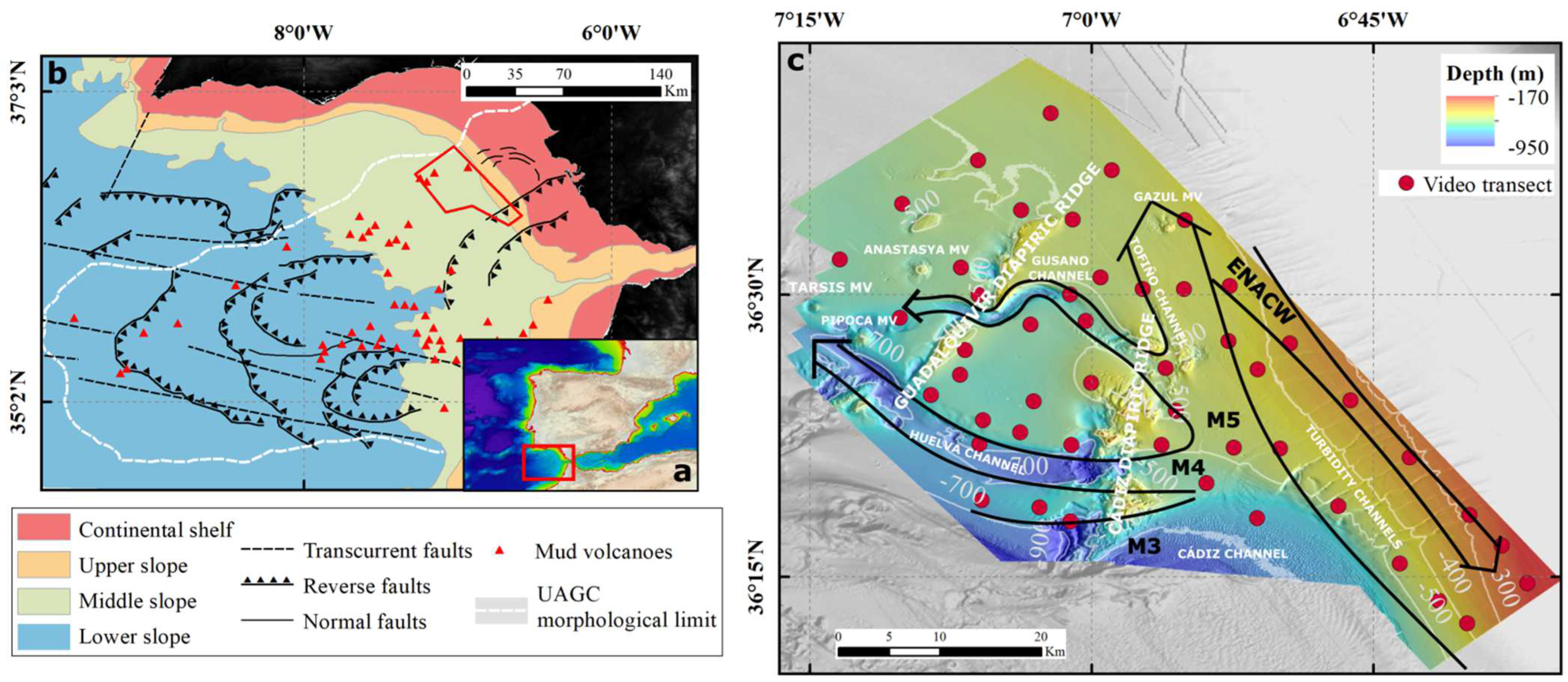
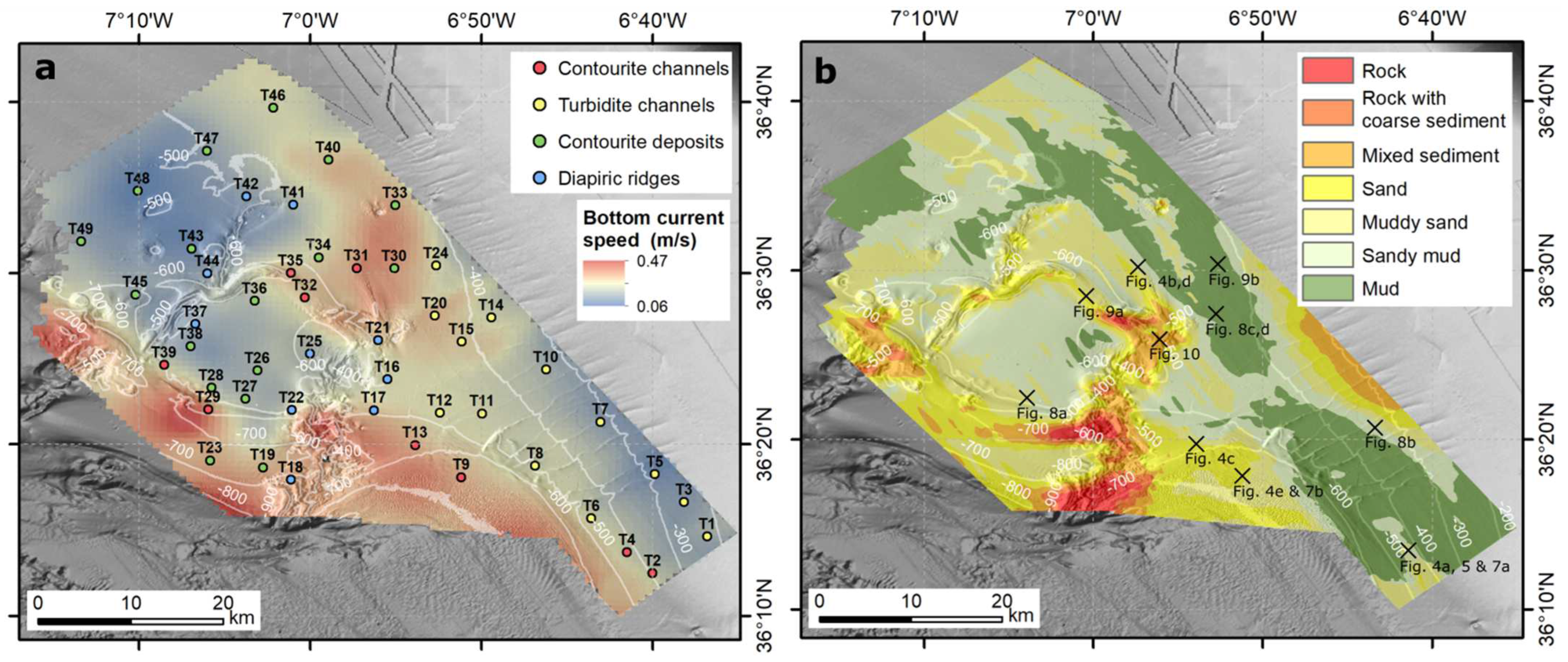
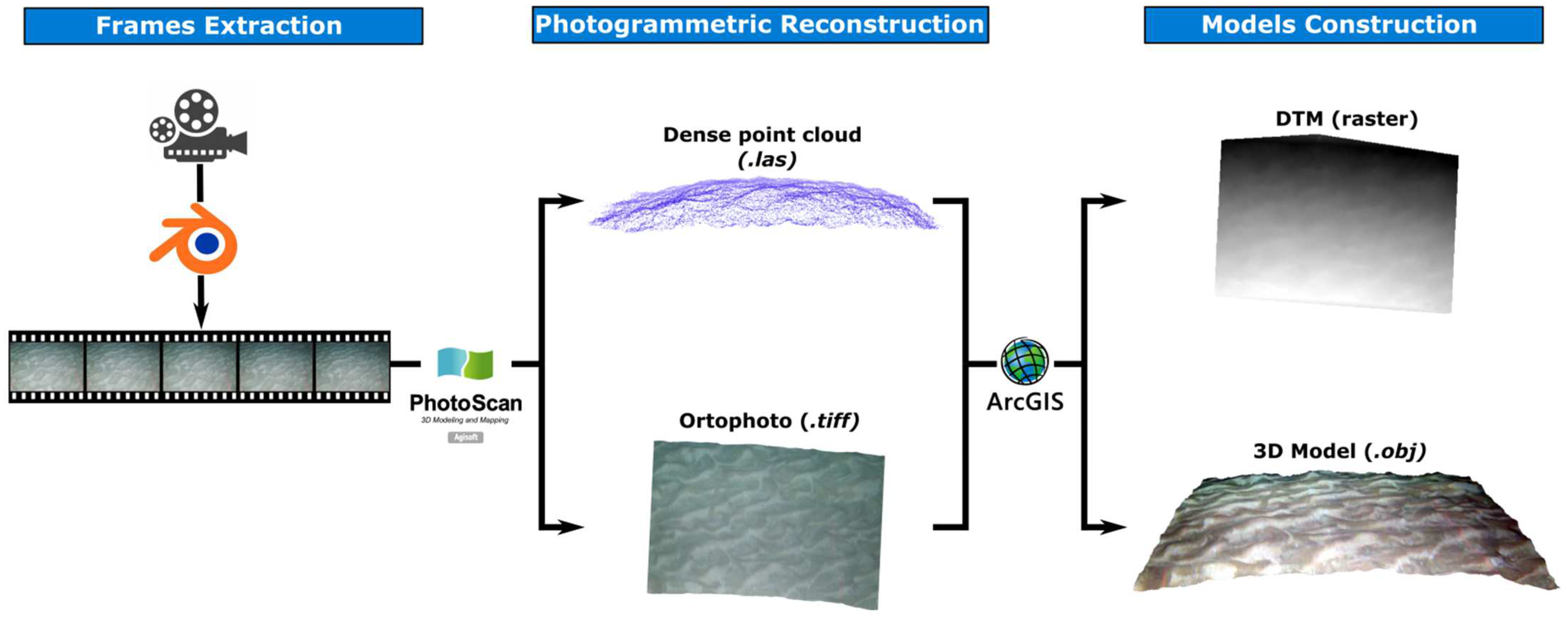
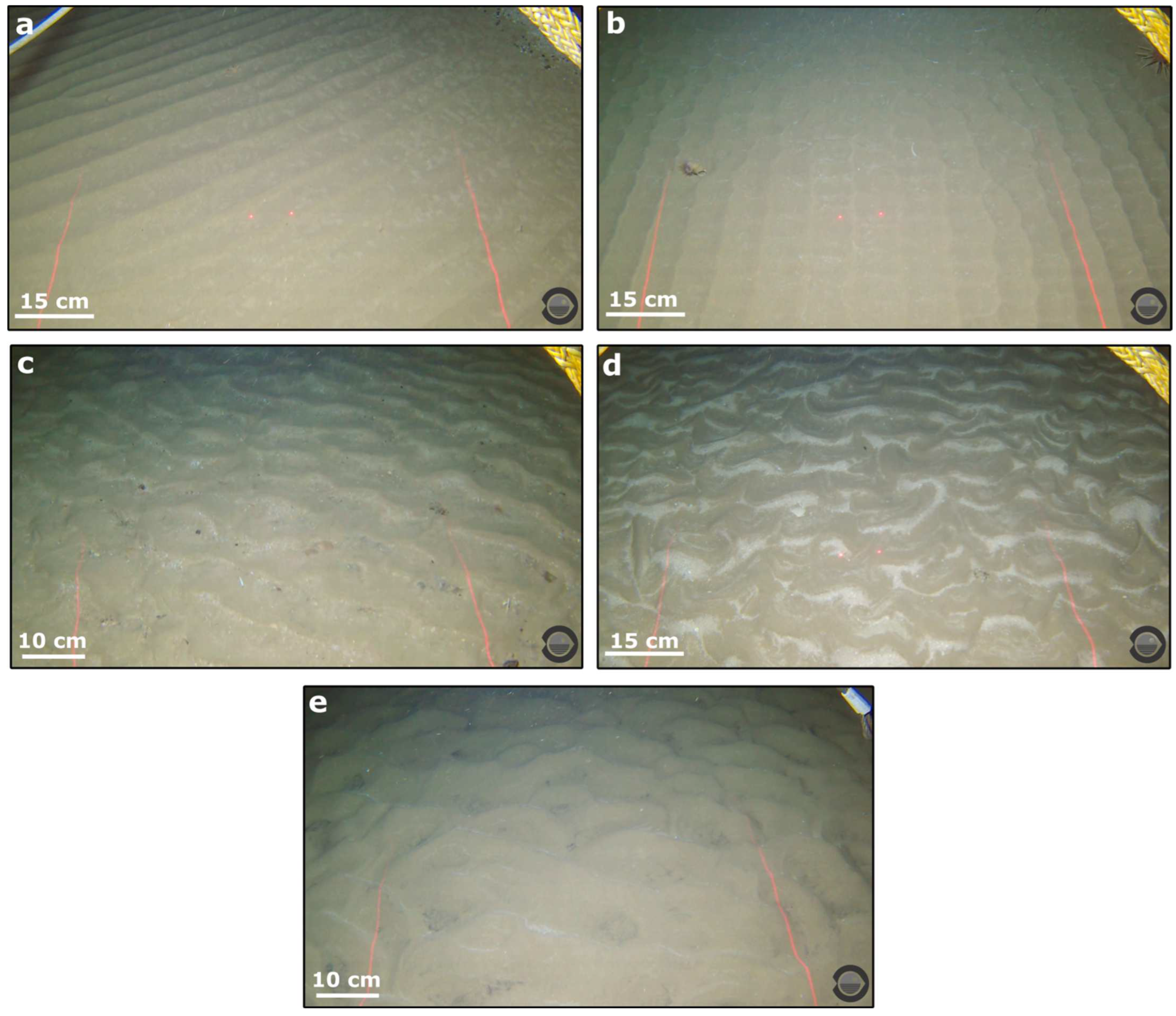

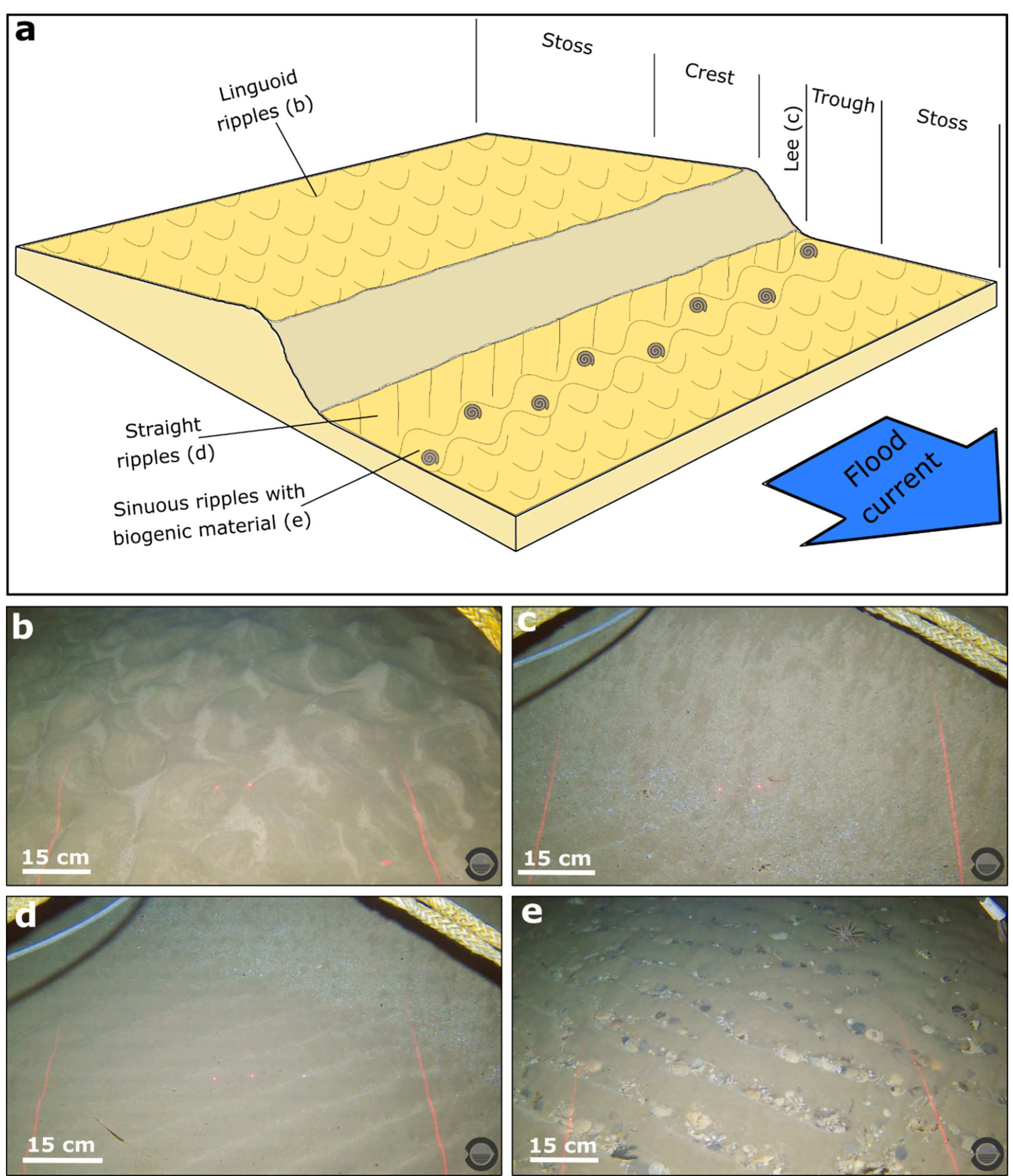
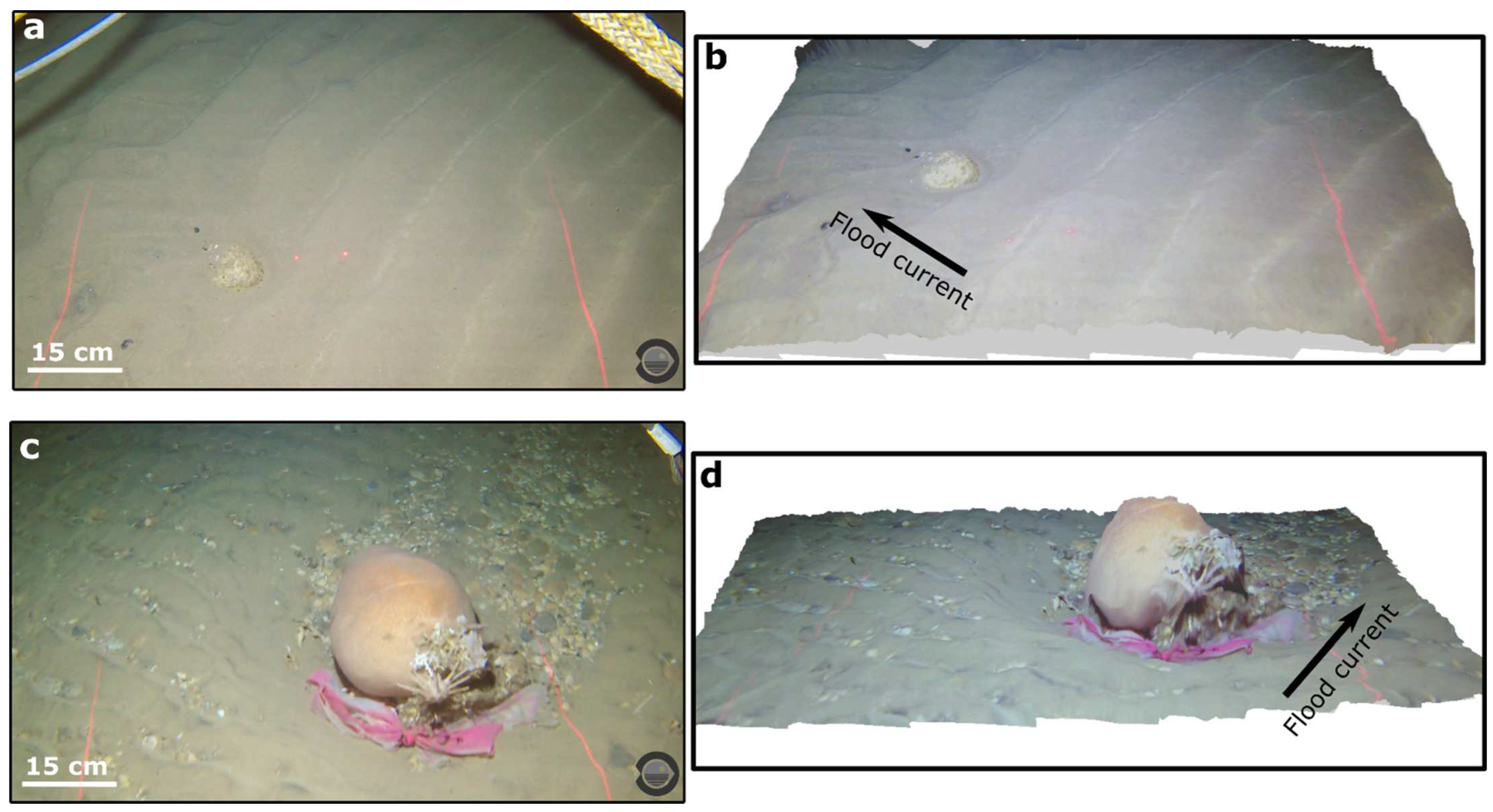
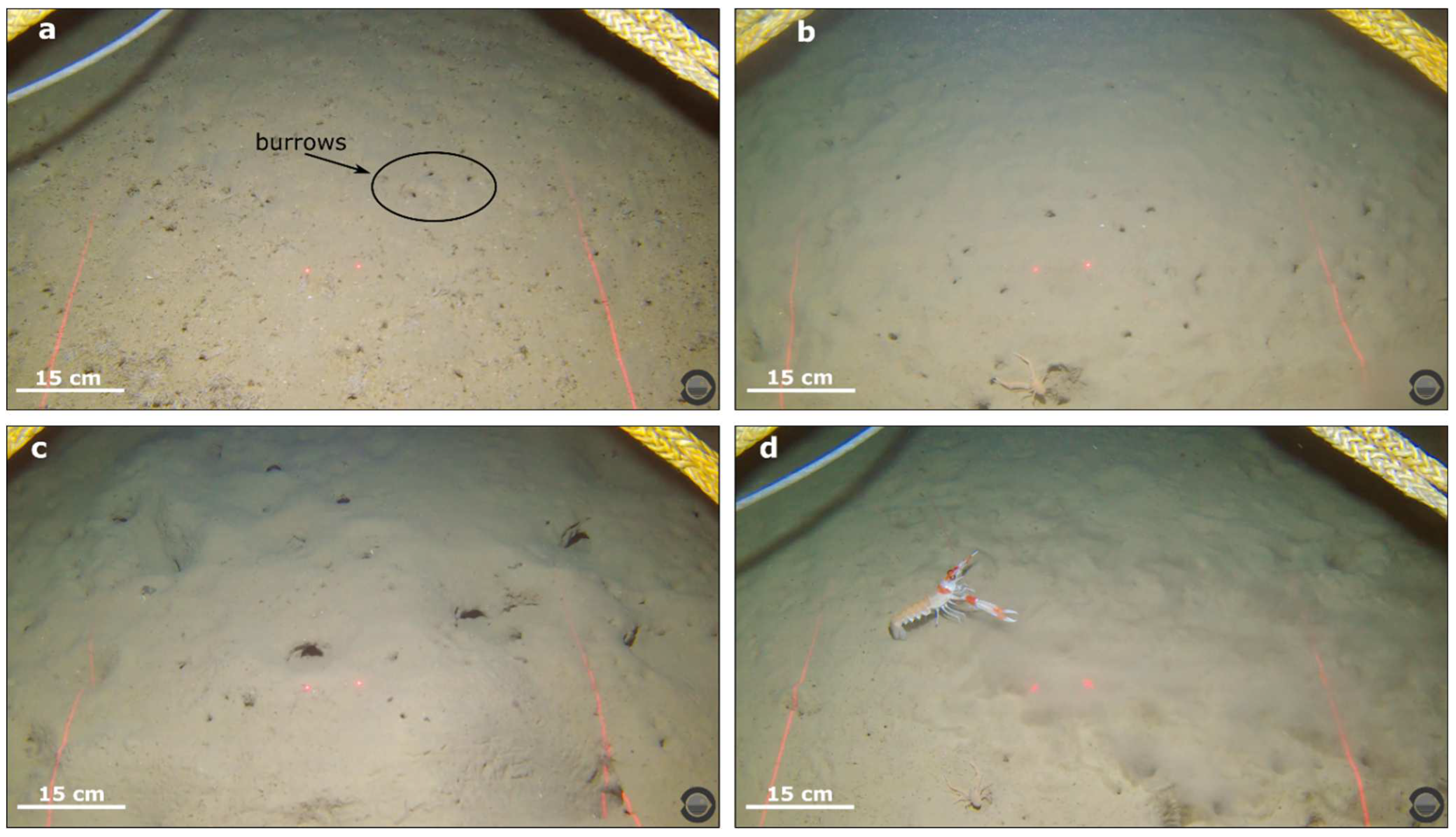


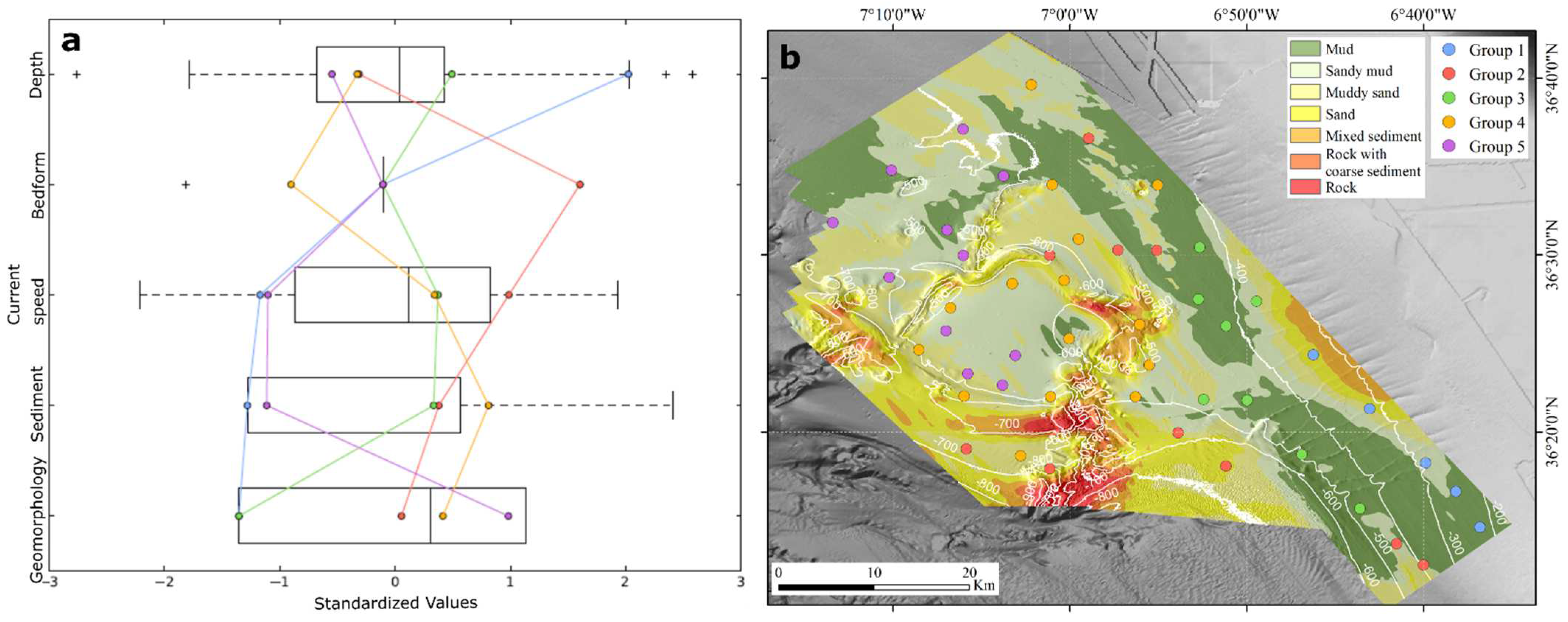
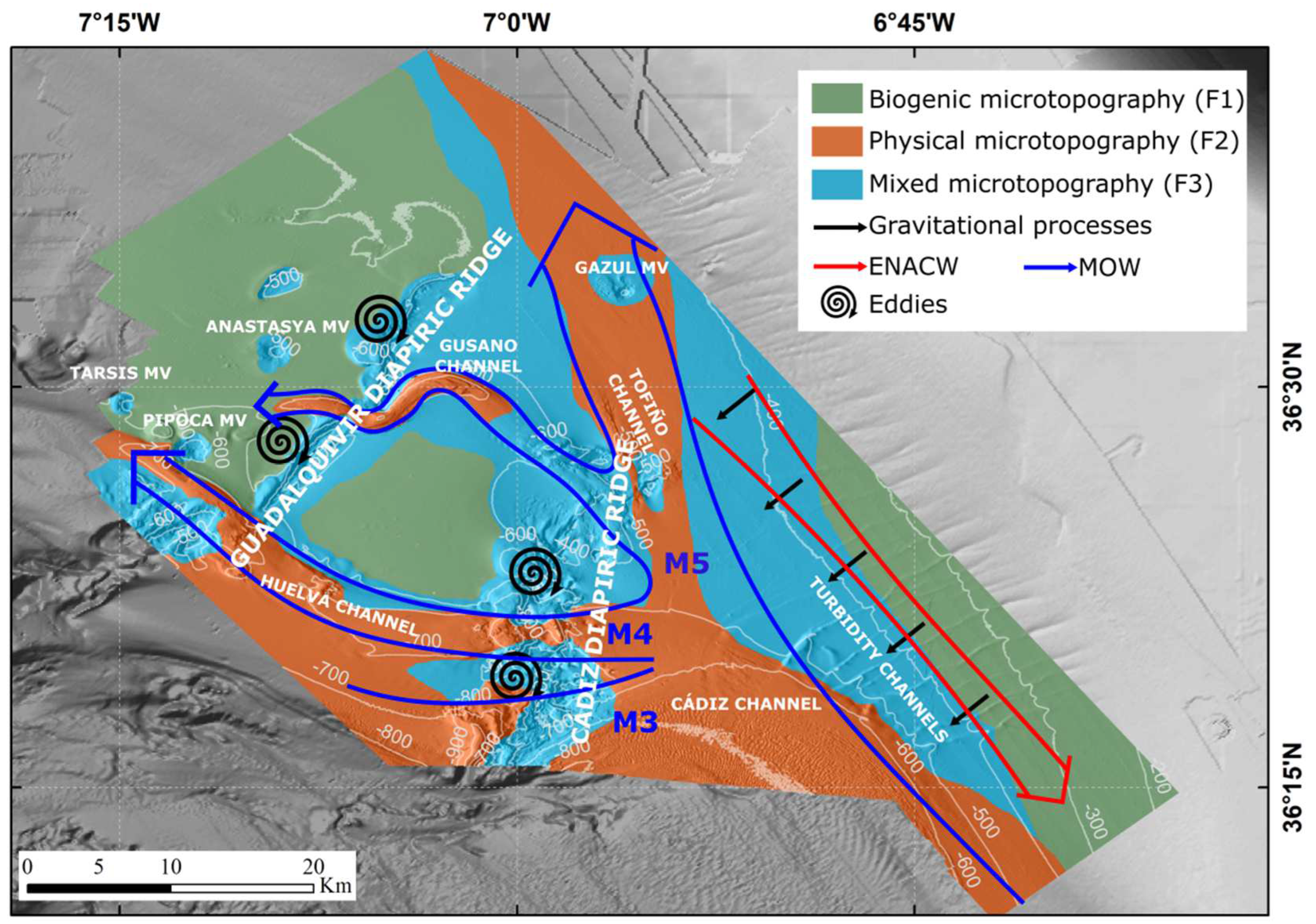
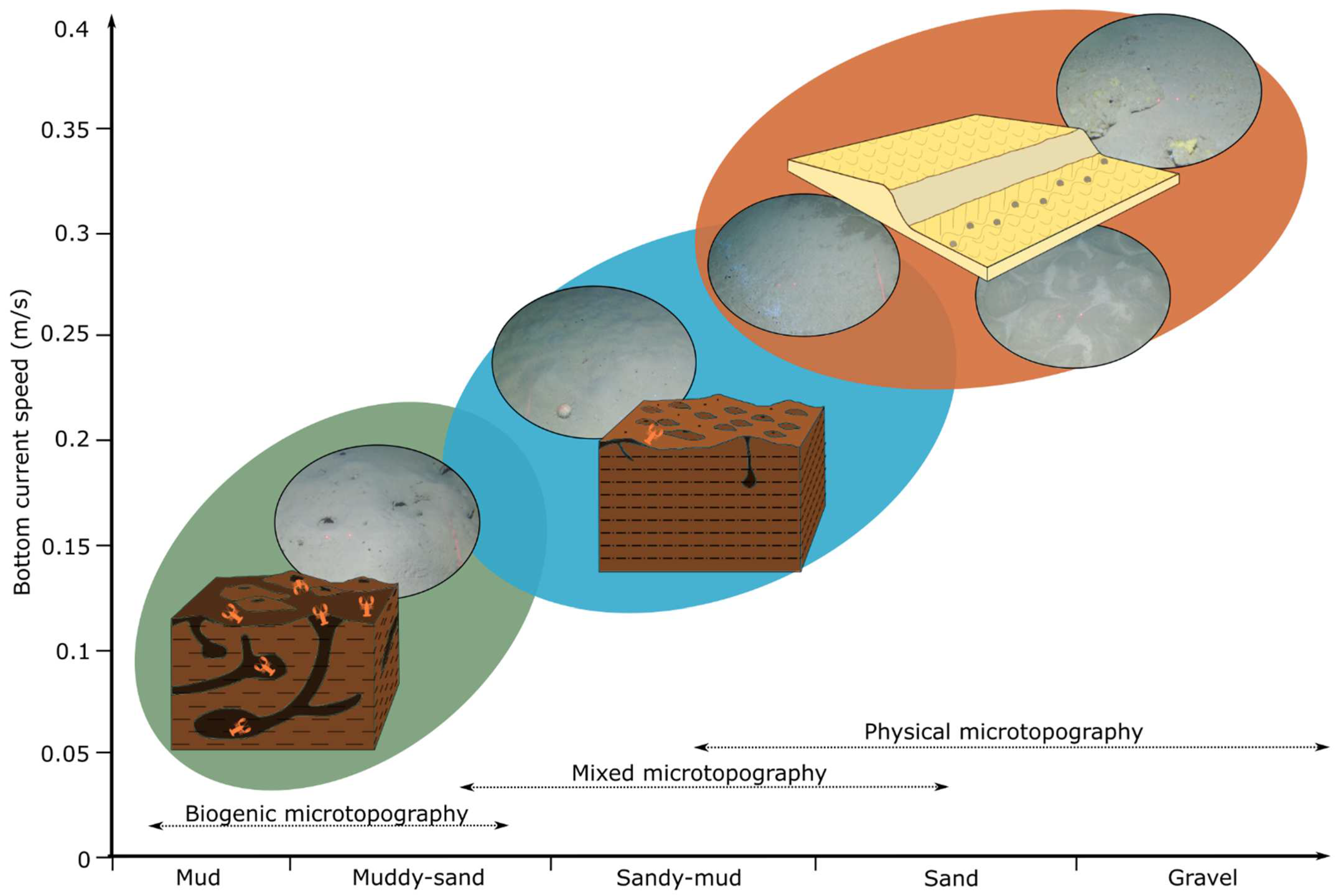
Publisher’s Note: MDPI stays neutral with regard to jurisdictional claims in published maps and institutional affiliations. |
© 2022 by the authors. Licensee MDPI, Basel, Switzerland. This article is an open access article distributed under the terms and conditions of the Creative Commons Attribution (CC BY) license (https://creativecommons.org/licenses/by/4.0/).
Share and Cite
Jiménez-Romero, R.; Fernández-Salas, L.M.; Palomino, D.; Sánchez-Leal, R.F.; Vila, Y. Discovering the Fine-Scale Morphology of the Gulf of Cádiz: An Underwater Imaging Analysis. J. Mar. Sci. Eng. 2022, 10, 651. https://doi.org/10.3390/jmse10050651
Jiménez-Romero R, Fernández-Salas LM, Palomino D, Sánchez-Leal RF, Vila Y. Discovering the Fine-Scale Morphology of the Gulf of Cádiz: An Underwater Imaging Analysis. Journal of Marine Science and Engineering. 2022; 10(5):651. https://doi.org/10.3390/jmse10050651
Chicago/Turabian StyleJiménez-Romero, Raúl, Luis Miguel Fernández-Salas, Desirée Palomino, Ricardo Félix Sánchez-Leal, and Yolanda Vila. 2022. "Discovering the Fine-Scale Morphology of the Gulf of Cádiz: An Underwater Imaging Analysis" Journal of Marine Science and Engineering 10, no. 5: 651. https://doi.org/10.3390/jmse10050651
APA StyleJiménez-Romero, R., Fernández-Salas, L. M., Palomino, D., Sánchez-Leal, R. F., & Vila, Y. (2022). Discovering the Fine-Scale Morphology of the Gulf of Cádiz: An Underwater Imaging Analysis. Journal of Marine Science and Engineering, 10(5), 651. https://doi.org/10.3390/jmse10050651





